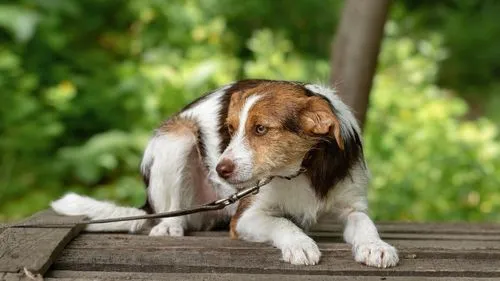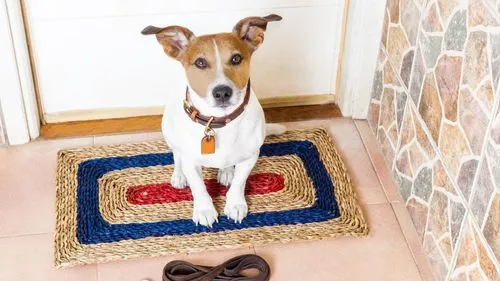How to keep your dog entertained when alone: Toy tips
March 04, 2024
Katka

Keeping dogs entertained while you're away is crucial for their well-being. With dogs living more indoor lifestyles, they need mental and physical stimulation to stay happy. This includes safe toys, outdoor play, and activities suited to their breed.
So, how can you keep your beloved canine companion entertained even when you’re away and they’re alone? Keep on reading to learn more.
The importance of keeping dogs entertained during their alone time
In the modern era, where dogs are more often companions in urban and apartment settings rather than working animals in rural areas, the necessity of keeping them entertained during their alone time has become more pronounced.
Understanding the shift in a dog’s lifestyle
Historically, dogs were bred for specific working roles, which provided natural physical and mental stimulation. Today, as household pets, they have less innate job-related activities, making it crucial for pet owners to substitute this with other forms of engagement.
What more, the move from spacious outdoor environments to smaller, indoor spaces, particularly in urban areas and apartments, has drastically reduced the natural stimuli available to dogs. This shift necessitates a more active role from owners in creating stimulating environments.
This lifestyle change has led to an increase in separation anxiety among dogs, a condition where dogs exhibit stress and anxiety behaviors when left alone.
Engaging dog toys for backyard play
When selecting toys for dogs to enjoy while they're alone outdoors, it's crucial to prioritize their safety, engagement, and the appropriateness of the toys for solo play. Here are some suitable options that ensure your dog can have fun safely in your backyard.
Durable chew toys: Opt for chew toys made from tough materials like heavy-duty rubber or durable nylon. These toys are great for outdoor use, providing a satisfying and safe chewing experience that can keep your dog occupied for hours.
Treat-dispensing puzzle toys: These toys are excellent for mental stimulation, as they challenge your dog to solve puzzles to access treats. They're perfect for keeping your dog engaged and can be used safely in an outdoor setting.
Automatic ball launchers: For dogs that love fetching, automatic ball launchers can provide endless entertainment. Ensure the launcher is set to a safe distance, especially in fenced areas, to keep the playtime fun and secure.
Tug-of-war toys: Durable rope toys can provide the opportunity for intense play without the need for human interaction. The tug-of-war rope needs to be securely fastened to avoid endangering the dog's health. Ideally, the rope should be attached to a tree.
Little dog pools: A shallow, dog-specific pool can offer a safe way for your dog to cool off and play in the water without the risks associated with deeper pools. These pools are designed for splashing and lounging, providing a refreshing outdoor activity.
Water toys for shallow play: In conjunction with a little dog pool or on their own, water toys that float and are easy to grab can add an element of fun to your dog's water play. These toys are ideal for encouraging light, safe water interaction in shallow areas.
Scented toys: Toys with engaging scents can stimulate your dog's sense of smell, encouraging them to explore and play. Hiding these toys around your yard can provide a fun and interactive game of hide-and-seek.
Interactive noise-making toys: Noise-making toys that are durable and safe for outdoor use can keep your dog interested for longer periods. The sounds produced by these toys can provide comfort and entertainment, especially for dogs that respond well to auditory stimuli.
Agility equipment for the backyard: Setting up agility equipment in your backyard, such as hurdles, tunnels, and weave poles, can provide a stimulating and physically demanding activity. It's an excellent way for your dog to get exercise while also strengthening your bond through interactive training.
Scent trails and hidden treat games: Creating scent trails or hiding treats around your backyard can engage your dog's natural instincts to forage and track. This type of play promotes mental stimulation and problem-solving skills.

Safety considerations for solo outdoor play
By carefully selecting toys that are designed for safe and enjoyable solo outdoor play, you can provide your dog with a stimulating environment that encourages physical activity and mental engagement, even when they're playing alone. The most important principles are:
- Regular checks: Periodically inspect all toys for signs of wear and tear to ensure they remain safe for play.
- Appropriate toy selection: Choose toys that are suitable for your dog's size, breed, and play style to prevent any potential choking hazards or injuries.
- Weather conditions: Consider the current weather and outdoor conditions when selecting toys, avoiding anything that could become dangerous in extreme temperatures or weather events.
Engaging dog toys for playing inside the house
Apartment living poses specific challenges for dogs, primarily due to limited space and the absence of a backyard. The significance of physical activity when leaving dogs alone cannot be understated. It is a cornerstone of their health and happiness. In the absence of adequate physical engagement, dogs can develop a host of issues, such as obesity, restlessness, and even destructive behaviors.
When selecting toys for unsupervised play, safety and durability are paramount. Toys must be engaging enough to keep your dog's attention for extended periods, mitigating the risk of boredom and associated destructive behaviors.
Interactive puzzle toys: Puzzle toys are excellent for mental stimulation, challenging your dog to think and solve problems to receive rewards. They come in various difficulties, catering to all levels of canine intellect and curiosity.
Treat-dispensing toys: These toys not only entertain but also reward your dog for their problem-solving efforts. They can keep dogs occupied for hours, trying to maneuver the toy in just the right way to release treats.
Chew toys for dental health: Chew toys are essential for solo play, promoting dental health while satisfying the natural urge to chew. Durable materials are key to ensure these toys withstand vigorous chewing without breaking apart.
Sensory stimulation toys: Toys that appeal to your dog's senses, such as those with different textures, sounds, or light-up features, can provide a varied and enriching solo play experience, keeping engagement levels high.
Soft plush toys with built-in noises: Plush toys that mimic animal sounds or contain squeakers can offer comfort and auditory stimulation, making them ideal companions for dogs when they are alone.
Rope toys: Durable rope toys or devices that simulate a game of tug-of-war can provide vigorous play options without the need for human interaction, perfect for keeping dogs engaged and active. You can attach the rope to a wooden pole or a fixed anchor to a wall. It is important not to injure the dog while playing.
Safety precautions for solo play toys
- Toy checks: It's vital to ensure that all toys are safe for unsupervised play, particularly in an apartment setting where space is limited. Regular inspections for wear and tear are crucial to prevent accidental ingestion of broken parts.
- Dog check: It is also important to check you dog regularly. Thanks to technology, we now have previously unimaginable possibilities. One of them is Barkio dog monitoring app, a game-changer for pet parents, allowing you to keep an eye on your furry friend from anywhere. The app offers live video streaming, two-way audio and video, commands and activity alerts, ensuring you're always connected to your dog's well-being, even when you're away. It's an invaluable tool for monitoring how your dog interacts with their toys and ensuring they're safe and content.

What not to give the dog to play with
Dogs often play with what they find. However, it is not advisable to leave things lying on the ground that can harm the dog. These include:
Wood
Dogs love to chew wood - it sharpens and cleans their teeth. But beware! A dog can get splinters or pieces of wood stuck in his gums, which can really harm him. If you find something stuck in the gum, don't delay too long and see the vet! You'd better buy him some good quality bones to chew on.
Shoes and everyday items
Avoid toys that resemble objects from your household, such as pillows, old slippers and shoes or sweaters If you get your dog such a toy, you will inadvertently teach him that these are things meant for play. The dog may then think of all your shoes as toys to chew on and fool around with.
Children's toys
Forget about children's toys that contain small parts that can be easily separated. Such toys have a high risk of becoming detached and being swallowed by the dog. The consequence is at least digestive problems, and in worse cases the dog may also choke on the toy. The big problem is toys with batteries. Batteries in the digestive tract cause tissue necrosis and without timely intervention, such innocent play often ends in the death of the dog.
Engaging in physical activity: Tailoring to your dog’s needs
Dogs of many breeds live with humans, each with its own unique needs. There are dogs that can sleep most of the day and those that need to be on the move all day. It is therefore important to adapt the program to your dog so that they are adequate for him/her.
Dogs can have not only physical but also mental signs of distress. A dog deprived of sufficient exercise may exhibit signs of depression, anxiety, or stress.
Strategies based on breed
- High-energy breeds: For breeds like Labrador Retrievers and Border Collies, incorporate interactive toys that mimic outdoor activities, like automated ball launchers. Agility training equipment can also be set up in a safe space for them to navigate.
- Medium-energy breeds: Breeds such as Beagles or Cocker Spaniels thrive on moderate exercise. Toys that engage them in moderate physical activities, like treat-dispensing balls, can keep them entertained.
- Low-energy and physically limited breeds: For breeds like Bulldogs or older dogs, gentle play is key. Consider engaging toys, such as rope toys and sensory balls, which stimulate their senses without demanding much physical effort.

Do not ignore the role of dog food
As they become active, however, they will eventually become hungry. It's essential to consider their dietary needs alongside their physical activities. For example, active breeds like Huskies require nutritious and energy-rich diets to maintain their vigor. Owners might find exploring some favorite dog foods for Huskies helpful in keeping up with their high energy levels while ensuring overall health and well-being.
Looking for more information about how to feed your dog to keep them physically active even while you’re away? Perfect Dog Breeds' official website has more information about picking the right dog food, as well as other information about various dog breeds.
Mental stimulation strategies: Beyond physical play
Just as physical exercise is essential for a dog's body, mental stimulation is crucial for their cognitive health and emotional well-being. In the confined spaces of modern living, where natural stimuli are limited, providing mental challenges becomes imperative to prevent boredom and related behavioral issues.
Strategies based on breed
- Intelligent and High-energy breeds: Poodles or Australian Shepherds will benefit from complex puzzles that challenge their intellect. Interactive toys that require them to solve problems to get treats are ideal.
- Breeds with tracking abilities: Utilize their natural scent-tracking skills. Hiding treats or using scent trails can provide a fulfilling mental workout for Beagles or Bloodhounds.
- Less demanding breeds: Simpler interactive toys that provide mental stimulation without overwhelming them, such as rubber chew toys and snuffle mats, are perfect for breeds like Bulldogs.
Consider their auditory environment
In addition to visual and physical stimuli, the auditory environment of your dog plays a significant role in their mental stimulation and comfort. Dogs, much like humans, can be influenced by the sounds around them.
- Music for canine ears: Studies have shown that certain types of music, especially classical, can have a calming effect on dogs. Playing soft, soothing tunes can help reduce feelings of anxiety and loneliness in your dog while you're away. Heartbeat toys can be beneficial, especially for puppies.
- ** Leaving the TV on:** For some dogs, leaving the television on can provide a semblance of company and normalcy. The sounds and sights of a TV can simulate the familiar noise of human presence, making them feel less isolated.
Volume and content consideration: It's essential to keep the volume at a moderate level and consider the content being played. Avoid channels or music that might have sudden loud noises or elements that could startle or confuse your dog.
Is your dog afraid of certain sudden noises? Try the free app Furbino, which allows you to train your dog's sensitivity to specific sounds throughout the year. Furbino's sound library contains more than 60 sounds, making it the right tool!

Frequently asked questions
1. How can I tell if my dog is getting enough mental and physical stimulation?
Signs of adequate stimulation include a calm demeanor, regular eating and sleeping patterns, and an absence of destructive behaviors. If your dog seems restless, is chewing on furniture, or shows other signs of stress, they might need more stimulation.
2. Are interactive toys safe for dogs when they’re alone?
Yes, most are designed for safe solo play. However, choose sturdy toys that can't be easily chewed apart, and avoid toys with small, swallowable parts. Always introduce new toys when you're present first to ensure they're safe.
3. How long should I leave my dog alone?
The duration can differ based on factors such as the dog's breed, age, and overall health. Most dogs can handle being alone for 4-6 hours, but puppies, elderly dogs, or those with medical conditions may need more frequent check-ins. Read more in the article How long can a dog be left alone.
Conclusion
The goal of all these efforts is your love and commitment to your dog's happiness and well-being. Your absence is not only something negative, it is also an opportunity to explore, play and relax. Dogs, like humans, love company, but they also need time alone. Thanks to this article, you already know how to properly entertain your dog. So let's do it!
Continue reading...
Show all articlesCopyright & trademark notices
Apple, the Apple logo, and iPhone are trademarks of Apple Inc., registered in the U.S. and other countries and regions. App Store is a service mark of Apple Inc. Mac App Store is a service mark of Apple Inc. Google Play and the Google Play logo are trademarks of Google LLC. Windows® and the Windows logo are either registered trademarks or trademarks of Microsoft Corporation in the United States and/or other countries. Linux® is the registered trademark of Linus Torvalds in the U.S. and other countries.


